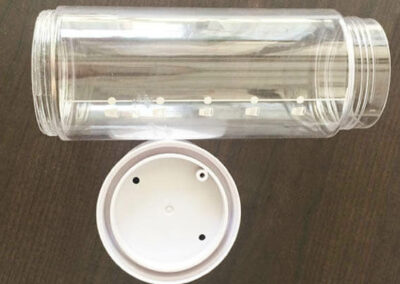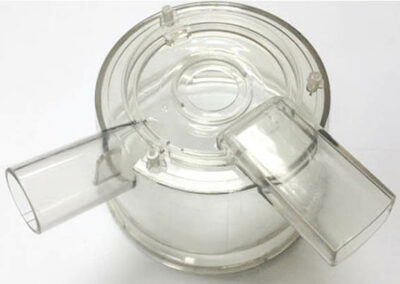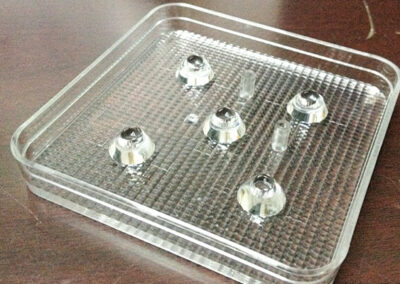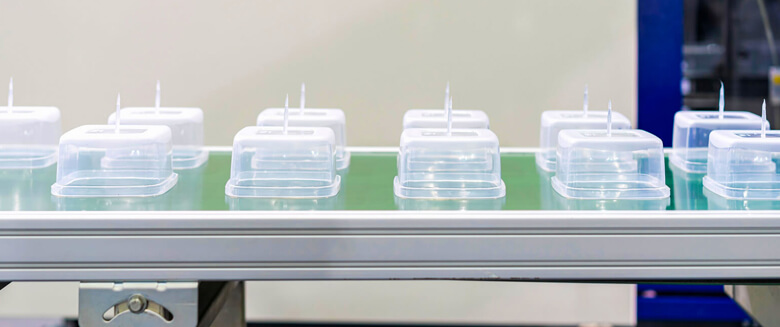Clear Plastic Molding: How to Mold Clear Plastic Parts
There are many common clear plastic molding parts, clear injection molded plastics or finished products in daily life, such as lenses, food-sealed box and acrylic products. Clear plastic molding is a manufacturing process used to produce transparent plastic products with a clear and see-through appearance. It involves injecting melted plastic material into a mold cavity, which is shaped like the desired product. Once the plastic cools and solidifies within the mold, it takes the shape of the mold cavity and becomes the final product. By using different techniques and process procedures, plastic molding manufacturers can create different custom clear plastic parts and finished products.
What are Clear Plastic Parts
Clear plastic parts are components or objects made from a transparent or translucent plastic material. These parts are typically used in applications where visibility or transparency is desired, such as in optical devices, windows, packaging, and medical devices. Clear plastic parts can be made using various molding processes, including injection molding, blow molding, and thermoforming.
Clear plastic molding parts can be made from a wide range of plastic materials, including polycarbonate, acrylic, PET, and PVC. The choice of material will depend on the specific application and the desired properties of the part, such as strength, temperature resistance, and chemical resistance.
Clear plastic molding parts can be produced in a variety of shapes and sizes, ranging from small lenses or packaging components to large windows or housings for electronic devices. Clear plastic parts are often used in industries such as automotive, consumer goods, medical, and aerospace, where transparency and durability are important factors.
Applications of Clear Plastic Parts
Clear injection molded plastic is used to make a wide variety of parts and products across many industries. Some commonly used clear plastic molding parts and applications of clear injection molded plastic include:
In the automotive industry, clear plastic molding parts are used for headlights, taillights, and instrument panels. In the medical industry, clear plastic molding parts are used for medical devices, such as syringes, IV bags, and medical imaging equipment. In the consumer products industry, clear plastic molding parts are used for packaging of food, toys, electronics, cosmetics and household items. And in the transport industry, clear plastic molding parts are used for cockpit windows and aircraft windshields,vehicles windows, and boats windows.
In other aspects, clear injection molded plastic is often used to: make lenses for eyewear, cameras, and other optical devices, make lenses and diffusers for lighting fixtures, make displays for electronic devices(such as smartphones and tablets), make housings for electronic devices and appliances. Additionally, Clear injection molded plastic is used for signage, such as in-store displays and outdoor signs, and is used to make furniture such as chairs, tables, and shelves, especially acrylic material.
Introduction of Clear Plastic Molding
Clear plastic molding is a manufacturing process used to create transparent, high-quality plastic parts. This process is commonly employed in a wide variety of industries, including automotive, medical, electronics, and consumer goods. The end products can range from small items like plastic bottles or food containers to larger items like car headlights or even airplane windows. The only distinction between clear plastic molding and other types of injection molding lies in the coloring agent. Utilize a clear coloring agent and exercise caution to prevent any contamination of the plastic with dirt or debris, ensuring a pristine, transparent final product.
Let us continue to explore clear plastic molding, clear injection molded plastics, and clear plastic parts.
Advantages of Clear Plastic Molding
Clear plastic molding offers several advantages over other molding techniques. One of the key advantages is transparency and clarity. Clear plastic is prized for its ability to let light pass through, making it ideal for applications where transparency is essential, such as windows, lenses, and displays. Additionally, clear plastic is highly durable, resistant to impact and weathering, and can be easily fabricated into complex shapes. And because it can be molded into virtually any shape or size, clear plastic molding offers unparalleled design flexibility. Finally, clear plastic molding is often more cost-effective than other molding techniques, making it a popular choice for many manufacturers.

Types of Clear Injection Molded Plastics
Clear injection molded plastics are used in a wide range of applications, including automotive parts, medical devices, consumer products and aerospace components. Here are some of the most common types of clear injection molded plastics:
- 1. Polycarbonate (PC):
Polycarbonate is a clear plastic molding alternative that is more costly than acrylic or HDPE. It has similar transparency and UV-resistance as acrylic, but is more resistant to damage from extreme temperatures. Polycarbonate’s high impact resistance makes it a popular choice for safety-related products such as windows, containers, helmets, and safety goggles. However, like acrylic, it requires drying after absorbing moisture before injection molding can occur.Polycarbonate is a popular material for clear injection molded parts because of its high impact resistance, transparency, and durability. It is commonly used for automotive headlamps, safety glasses, and medical devices. - 2. Acrylic (PMMA):
Acrylic is a versatile plastic that can be used for injection-molding applications to create clear and colored products. Its non-toxic composition, scratch-proof surface, and resistance to UV rays make it a popular choice for outdoor equipment. Acrylic’s ability to accommodate a variety of colorants makes it a suitable material for lenses, light fixtures, and other objects that require clarity. However, acrylic’s rigidity and susceptibility to breakage make it unsuitable for products that must withstand significant pressure. Additionally, it requires drying after absorbing moisture, which may slow down the manufacturing process and pose problems for end-users. - 3. High-density polyethylene (HDPE):
HDPE, similar to acrylic, demonstrates UV-resistance. However, it exhibits enhanced ease during translucent injection molding processes. Although HDPE is less prone to brittleness compared to acrylic, and more cost-effective to manufacture, it is susceptible to breaking under extreme pressure. These specific attributes make it a frequent choice for the production of containers, particularly bottles, and piping systems. HDPE is synthesized through the application of high temperature and pressure to petroleum. Given its transparency post-injection molding and its cost-effectiveness, it is favored in large-scale production scenarios. - 4. Polyethylene Terephthalate Glycol (PETG):
PETG is a clear plastic that is commonly used for food packaging, medical devices, and consumer products. It is known for its clarity, toughness, and ease of processing. - 5. Polystyrene (PS):
Polystyrene is a low-cost material that is commonly used for clear injection molded packaging, such as CD cases, food containers, and medical trays. It is known for its clarity, stiffness, and good dimensional stability. - 6. Polypropylene (PP):
PP is a naturally transparent amorphous thermoplastic known for its exceptional flexibility. This versatile material finds frequent use in textiles, packaging, and containers, while its remarkable electrical resistance makes it a favored choice in the electronics industry. Moreover, due to its inert nature, PP remains unaffected by acids and bases, making it an ideal option for storing solvents and other corrosive substances. - 7. Polyetherimide (PEI):
PEI is an amorphous thermoplastic resin known for amber transparency. This see-through material finds extensive applications in the automotive, electrical, and medical industries, thanks to its remarkable ability to withstand extreme temperatures and constant forces. PEI stands out due to its impressive deflection temperature (200°C / 392°F at 264 psi / 1.82 mPa), high tensile strength, and excellent mechanical properties retention at elevated temperatures. It boasts UV resistance and can endure substantial pressure and heat. What’s more, PEI possesses inherent flame resistance without the need for additives and maintains its chemical stability even when in contact with acids. As a result, it finds uses in heat shields, temperature sensors, aerospace engine components, and various electrical parts and covers. - 8. Optical Silicone Rubber(OLSR)
OLSR is a cutting-edge material with a variety of qualities that make it a better option than polycarbonate (PC) or acrylic (PMMA) for lighting and transparent optical components. Each substance limits the quantity of light that can pass through it. You can increase light transmission when your product calls for a clear PC or PMMA part by employing OLSR, which permits up to 94% light transmission.The fact that it doesn’t yellow is still another benefit. Thermoplastics without additives are not UV-resistant, therefore prolonged exposure to light and sunshine could cause the parts to deteriorate and turn yellow. Because OLSR doesn’t yellow, it’s perfect for outdoor fixtures that are exposed to harsh environments. - 9. Styrene-Acrylonitrile (SAN):
SAN is a clear plastic that is commonly used for consumer products, such as housewares and toys. It is known for its clarity, toughness, and resistance to chemicals. - 10. Cyclo-Olefin Copolymer (COC):
COC is a clear plastic that is commonly used for medical and pharmaceutical applications, such as syringes and IV bags. It is known for its transparency, high moisture barrier, and good dimensional stability.
When selecting a clear plastic for injection molding, it’s important to consider factors such as the desired properties of the finished part, the required regulatory approvals, and the production volumes. The choice of material will impact the clarity, durability, and performance of the final product. Additionally, as a reputable clear plastic molding supplier, Sungplastic can help you select the right material and ensure the highest quality results.
Benefits of Clear Injection Molded Plastics
Clear injection molded plastics offer several benefits over other plastic molding techniques. One of the key benefits is a high-quality finish. Injection molding produces parts with a smooth, polished surface that requires little or no finishing. Injection molded plastics are also highly precise and consistent, making them ideal for applications where accuracy is critical. Injection molding is also faster than other molding techniques, allowing for higher production rates. And like clear plastic molding, injection molded plastics are often more cost-effective than other techniques.
Two most common clear injection molded plastics: Acrylics vs Polycarbonates.
- 1. Transparency: Acrylics exhibit higher transparency with a light transmittance of 92%, whereas PC has a light transmittance of 90%.
- 2. Impact Resistance: Polycarbonates are more impact resistant and flexible when compared to acrylics. Acrylics, on the other hand, are more brittle and rigid, making them susceptible to breaking or cracking upon impact, unlike PC.
- 3. Scratch Resistance: Acrylics offer better scratch resistance, whereas Polycarbonates are more prone to surface scratches.
- 4. Weather and Chemical Resistance: Polycarbonates outperform Acrylics in terms of weatherproofing and resistance to chemicals.
- 5. Fire Retardancy: While Polycarbonates can be manufactured to be fire-retardant, Acrylics lack this property.
Clear Plastic Molding Process
The choice of clear plastic molding process depends on several factors, including the size and complexity of the part, the desired finish, and the production volume. To ensure high-quality clear plastic parts, it is important to use high-quality materials and to maintain strict quality control throughout the manufacturing process. This includes monitoring the temperature and pressure during molding, as well as conducting thorough inspections of the finished products.
Vacuum forming is a good choice for large, simple parts, while injection molding is ideal for smaller, more complex parts. CNC machining is a good choice for parts that require a high level of precision and accuracy.
There are several different types of clear plastic molding processes, including injection molding, blow molding, and thermoforming. Injection molding is the most common method for producing clear plastic parts and involves injecting molten plastic into a mold cavity. The plastic cools and solidifies in the mold, taking the shape of the mold cavity. Blow molding is used to create hollow parts, such as bottles, and involves inflating a heated plastic tube into the shape of a mold. Thermoforming involves heating a sheet of plastic until it becomes pliable and then using a mold to shape it into the desired form.
The specific steps involved in clear plastic injection molding can vary depending on the type of molding process used and the specific part being produced. However, here is a general overview of the steps involved in injection molding, which is the most common method used to produce clear plastic parts:
- 1. Design and Tooling: The first step in clear plastic molding is designing the part and creating the mold that will be used to produce it. The mold is typically made of metal or plastic and is designed to the exact specifications of the part being produced.
- 2. Material Selection: The plastic material used in clear plastic molding is typically a thermoplastic, which can be melted and re-melted without degrading. The material is selected based on the specific properties required for the part, such as strength, temperature resistance, and chemical resistance.
- 3. Loading and Melting: The plastic material is loaded into the injection molding machine, where it is melted and brought to the appropriate temperature and pressure for injection.
- 4. Injection: The melted plastic material is injected into the mold cavity under high pressure, filling the mold and taking the shape of the cavity.
- 5. Cooling and Solidification: The plastic material cools and solidifies in the mold, taking the shape of the mold cavity.
- 6. Ejection: The finished part is ejected from the mold cavity using ejector pins or other mechanisms.
- 7. Finishing Operations: After ejection, the finished part may require additional finishing operations, such as trimming, deburring, or polishing.
- 8. Quality Control: Throughout the clear plastic molding process, strict quality control measures are taken to ensure the finished parts meet the desired specifications. This includes monitoring the temperature and pressure during molding and conducting thorough inspections of the finished products.
Custom Clear Plastic Parts Solutions from Sungplastic
Clear plastic molding and injection molded plastics are essential techniques for producing clear plastic parts for a wide range of applications. With their transparency, durability, design flexibility, and cost-effectiveness, clear plastic parts are likely to remain an important component of manufacturing in the years to come.
Each project have unique requirements. Custom clear plastic parts solutions generally involve manufacturing plastic components tailored to a client’s specifications and needs.
Some steps to custom clear plastic parts solutions from Sungplastic:
- 1. Identify your requirements: You can communicate with Sungplastic and determine the type of parts you require, including their dimensions, material specifications, tolerances, and quantities.
- 2. Research your suppliers: Know more about Sungplastic from Co. website. We have a track record of producing high-quality clear plastic parts and provide one-stop services catered to your industry.
- 3. Evaluate capabilities: Sungplastic has strong capabilities to meet your requirements. This includes the advanced production equipments, the diverse types of plastic materials (e.g., acrylic, polycarbonate, PETG), the production processes (e.g., injection molding, CNC machining, vacuum forming), and any additional services provided (e.g., design assistance, prototyping, finishing).
- 4. Request quotes and samples: Contact Sungplastic and consult the quotes of your project, including all relevant costs, such as tooling, production, and shipping. Additionally, we can provide samples of previous work to assess the products quality to you.
- 5. Logistics and delivery: Sungplastic offers advantages in terms of shipping costs and delivery time with a professional technical team and own automated production supply chain.
Sungplastic Focus on customized service production.
Communicate Your Project And Create a Win-Win Situation. Right Now!
FAQs About Clear Plastic Molding
- What are some common quality issues that can arise in clear plastic molding?
Common quality issues in clear plastic molding include surface defects such as scratches or bubbles, warping or distortion of the part, and inconsistent clarity or transparency. These issues can be addressed through careful process control and inspection procedures. - How can design considerations impact clear plastic molding?
Design considerations such as wall thickness, part geometry, and gating location can all impact the success of clear plastic molding. For example, thick walls can cause warping or sink marks, while complex geometries may require additional tooling or post-molding operations. - Can clear plastic parts be recycled?
Many types of clear plastic used in molding processes, such as PET and polycarbonate, can be recycled. However, the recycling process may be more challenging than with opaque plastics, as the optical properties of the plastic must be maintained.
About Sungplastic
Sungplastic is a plastic product manufacturer with rich experience in injection molding. According to the different product development requirements, we flexibly adjust the manufacturing process to achieve high quality, high efficiency and more economical.
We offer a variety of manufacturing services: Rapid Prototyping, Tool Making, Injection Molding, Product Design and Development, CNC Machining and Metal Stamping. You can choose from a variety of plastics, silicone rubber, or metal for your product. Regardless of mass production or small batch customization, Sungplastic has always been committed to providing assured, efficient and more economical one-stop processing services for your projects.
Contact us for a free quote and project review.
Get a free quote and design analysis today.
We’ll reply you within 6 working hours.
We respect your privacy.





